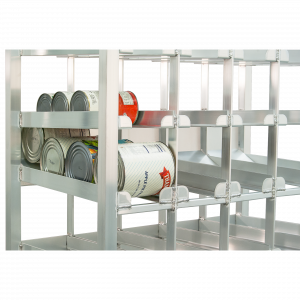 At the heart of our product manufacturing lies a commitment to utilizing 100% primary grade aluminum, a metal renowned for its robustness and longevity. The durability it offers over steel while remaining lightweight forms a primary rationale behind our choice of material. Moreover, aluminum possesses a unique attribute in its superior resistance to rust, setting it apart from other metals. In this discourse, we delve into the mechanisms underlying rust formation and expound on why aluminum adeptly fends off this corrosive phenomenon compared to its metallic counterparts.
At the heart of our product manufacturing lies a commitment to utilizing 100% primary grade aluminum, a metal renowned for its robustness and longevity. The durability it offers over steel while remaining lightweight forms a primary rationale behind our choice of material. Moreover, aluminum possesses a unique attribute in its superior resistance to rust, setting it apart from other metals. In this discourse, we delve into the mechanisms underlying rust formation and expound on why aluminum adeptly fends off this corrosive phenomenon compared to its metallic counterparts.
What is Rust?
The enigma of rust is demystified through an understanding of its chemical composition. Rust constitutes a chemical compound brought into existence through a specific reaction. When Iron Oxide atoms interact with hydrogen and oxygen atoms (H20), a chemical transformation transpires, yielding the telltale reddish residue known as rust. Moisture present in the atmosphere is a catalyst for rust formation, necessitating diligent measures to mitigate its impact on metallic materials. It is worth noting that rust’s realm is confined to steel and iron; other metals remain impervious to this phenomenon.
What is Corrosion?
Corrosion, akin to rust, constitutes an electrochemical process that manifests when metals succumb to deterioration. This process engenders the conversion of metals into more stable chemical compounds such as oxides, sulfides, and hydroxides via electrochemical reactions. Liquids, often moisture, exacerbate corrosion, accelerating the transformation into these compounds that subsequently erode the material and propagate damage throughout. It’s vital to differentiate corrosion from rust, as the former embodies a broader range of processes, while the latter hinges on iron oxidation. Corrosion, an umbrella term encompassing various degradation mechanisms, can lead to irreversible structural frailty if left unchecked.
 Why is Rust and Corrosion Bad?
Why is Rust and Corrosion Bad?
The ramifications of rust and corrosion are far-reaching, posing threats to objects, individuals, edifices, and more. The deleterious impact of these processes manifests in the gradual debilitation of metals, rendering them brittle and prone to breakage. This degradation has dire implications, ranging from structural collapses in buildings and bridges to ruptured pipes and fractured platforms. Given their swift propagation, early detection and intervention are paramount in averting potential harm.
Does Aluminum Rust?
Curiously, aluminum defies the stereotypes surrounding rust. While not impervious to rust, aluminum’s susceptibility pales in comparison to steel and iron. Importantly, the rusting of aluminum can engender a protective layer rather than causing harm. When exposed to oxygen, aluminum releases aluminum oxide atoms, which diffuse across the metal’s surface, forming a protective coating. This aluminum oxide layer, robust and nearly imperceptible due to its color similarity to aluminum, bolsters the metal’s safeguarding prowess. Unlike iron oxide, aluminum oxide remains steadfast, affording aluminum its superior rust-resistance.
Does Aluminum Corrode?
Notwithstanding its resilience, aluminum is not invincible against corrosion. Though more resistant, it can succumb under specific circumstances, particularly when aluminum oxide is compromised, exposing the underlying metal. Mere abrasion or scratching can facilitate this, albeit the aluminum oxide usually regenerates, albeit with potential interactions with airborne compounds. Among these, chlorides and sulfides emerge as chief antagonists, with sodium chloride, or salt, posing a substantial risk. When these compounds combine with bare aluminum, the stage is set for corrosion to ensue, gradually corroding the metal.
Why Aluminum?
The merits of opting for aluminum as the preferred metal are myriad, elucidating our rationale for exclusively employing it in our manufacturing processes. Foremost, aluminum boasts unparalleled protection against rust and corrosion, setting it atop the hierarchy of metal choices. Its lightweight nature renders transportation more convenient than steel. Furthermore, aluminum’s exceptional strength guarantees durability, ensuring the longevity of our products. While numerous other reasons bolster our allegiance to aluminum, these focal points encapsulate the essence of our preference.
How to Protect Aluminum from Corrosion.
Preserving aluminum from corrosion entails a judicious combination of environmental control and strategic intervention. Shielding aluminum from climatic conditions that foster corrosion, especially moisture-laden atmospheres, constitutes a proactive measure. Additionally, applying a protective finish, achieved through anodizing, bestows an imperceptible shield that safeguards the metal without altering its appearance.
In summary, aluminum’s resistance to rust and corrosion stems from its innate ability to form protective layers and its robust chemical properties. Embracing aluminum not only ensures enhanced product longevity but also reinforces our commitment to quality and durability.
New Age Industrial is the leading aluminum extruder and fabricator of storage and transportation equipment in the United States. We use a Flexible Manufacturing Process to design and build heavy-duty yet lightweight aluminum products that can be customized to fit your exact needs, completely stress-free. Our unmatched versatility in product design and in-house team of experts make New Age Industrial the Top Choice for material handling and food service equipment. Our products are Proudly Made in the USA!

